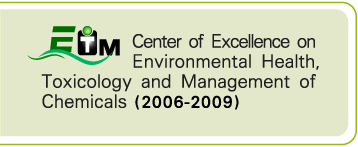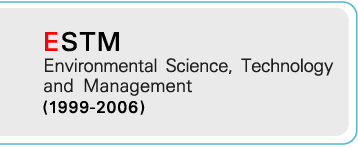|
This research work aimed to optimize in vitro cytotoxic assay using yeast as biological model. In particular, factors affecting yeast based cytotoxic assay and sensitivity of yeast after exposure to toxic substance have been investigated. Initially, four yeast strains have been evaluated and finally two of those which demonstrated a bit difference were selected for further study including S. cerevisiae ATCC 4105 and S. cerevisiae D7. Optimum cell densities for resazurin assay of both strains were 1×106 cells/ml while the optimum incubation time of S. cerevisiae ATCC 4105 and S. cerevisiae D7 were 3 and 4 hr, respectively. In growth inhibition assay, respective cell densities of 7×105 and 8×105 cells/ml and incubation time of 6 and 7 hr were found to be suitable for S. cerevisiae ATCC 4105 and S. cerevisiae D7. After exposure to ethanol, DMSO, H2O2, MMS, 4-NQO and CuSO4.5H2O, the viability of both strains in dose-response manner were observed. However, resazurin assay showed the advantage in assay time. When exposure to some essential oils (EO), namely, eucalyptus oil (Eucalyptus gloulus), tea tree oil (Melaleuca alternifolia), Kaffir lime oil (Citrus hystrix DC.) and citronella oil (Cymbopogen nardus), all EO showed cytotoxic effects however slightly stimulation effect on cell proliferation of Kaffir lime oil and citronella oil were found at low concentration. Tea tree oil showed the least toxic with IC50 of 0.6763+0.0022 and 0.7122+0.0040% (by volume) for S. cerevisiae ATCC 4105 และ S. cerevisiae D7, respectively. S. cerevisiae D7 was also applied to test the effects of hair shampoo, hair conditioner and liquid soap as well as their principal ingredients comprising of detergents, surfactants and preservatives. All hair shampoo products and ingredients could effectively inhibit the growth of yeast. Cytotoxic comparison using IC50s values indicated the most toxic of exposure to preservative, propylparaben. For hair conditioner and ingredients, IC50 of polyquaternium-11 and methyl paraben were 3.60+0.25%(w/v) and 5.46+1.07 mM, respectively. Mixture of stearyl alcohol and cetyl alcohol as well as conditioning products exhibited slightly toxic. Similar to hair shampoo, preservative used in liquid soap (Bronidox L®) was the most toxic with equal effect of foam booster (Comperlan KD®) following by detergent (Ammonium lauryl sulfate and Sodium lauryl sulfate). All test liquid soap inhibited more than 50% of yeast growth. Studied results mentioned above underline the feasibility of using both 2 strains of yeast in testing the cytotoxic effects of various compounds. It should be further developed as biological model for screening of toxic agents with simplified rapid technique and low cost operation. It was therefore furthermore investigated the use of this model for examination of cellular alterations after exposure to EO. Determination of intracellular glutathione (GSH) concentration alteration after exposure to EO has been optimized and investigated. Decreasing of intracellular GSH concentration was observed after exposure to citronella oil. Eucalyptus oil, Kaffir lime oil and Tea tree oil slightly reduced intracellular GSH which did not found after exposure to coconut oil, jojoba oil and moringa seed. Moreover, cell cycle distribution ushas been additionally optimized in order to investigation cellular effects of toxic agents on yeast. Optimum conditions for cell cycle distribution determination of S. cerevisiae D7 using flow cytometer were culture time of 4 hr, density of 3×105 cells/ml and incubation with PI during 30 min. แหล่งข้อมูล:
|
 Center of Excellence on Environmental Health and Toxicology (EHT)
Center of Excellence on Environmental Health and Toxicology (EHT)










